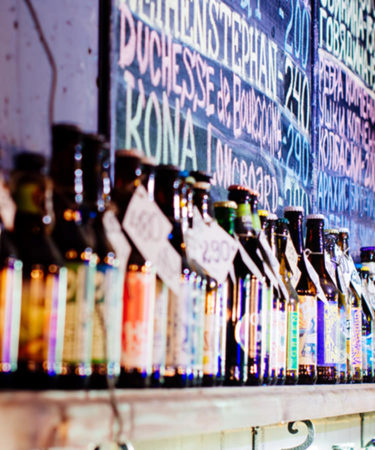At the California Craft Beer Summit last week, Brewers Association chief economist Bart Watson announced some good news: A record 7,000 brewers will be operating in the U.S. this year.
This compares to just over 6,200 at the end of 2017, marking a 13 percent increase in breweries year over year. And more are angling to open — a lot more; 9,000 active permits are filed with the Alcohol Tobacco Tax and Trade Bureau (TTB).
But while more breweries may be great news for us drinkers, it’s not all good news for brewers. More breweries means more competition, especially among regional brands. At the summit, Watson said, “There’s a lot of growth out there, but it’s not being realized by everybody because there are so many companies competing for that growth rate.”
Plus, craft breweries are not only competing with other local breweries, but with local wineries and distilleries.
His answer? Be(er) more like wine. By positioning beer as more “sophisticated” and convincing millennials to “drink a little bit better beer” — say, by targeting aging millennials who are looking for something fancy to bring to a party (hi! That’s me) — growth in the category can follow.
I couldn’t agree more. As I recently wrote in a story about the relevance of Cicerones:
A recent survey from the Beer Institute revealed that only 16 percent of adults aged 21 to 24 who drank alcohol in the last month consider beer “special,” and just 2 percent see it as “sophisticated.” Wine, on the other hand, was deemed special and sophisticated by nearly 40 percent of respondents.
Just as we’re seeing wine act more like craft beer — adopting trendier label designs, going the natural wine route, founding urban wineries appropriate for all-day hangs — beer can be elevated by way of its service, its packaging, and positioning. Consumers aged 25 to 34, Watson said, are reaching their craft beer “peak.” That’s me and my peers. We’re here, we want interesting, and we’re willing to pay for it. As more drinkers are convinced beer belongs at the dinner table, on the restaurant menu, or in a gift bag, the category can grow overall.
Schlitz Hits the Fan With Organizational Changes at Pabst
Last Wednesday, Pabst Brewing announced the departure of its CEO, Simon Thorpe, and COO Brian Bousely. Pabst chairman Eugene Kashper, who will reassume the role of CEO, said “this was not about cutting costs — but rather about becoming laser focused and unleashing the potential of our iconic brands in our platform as well as driving a truly entrepreneurial, small-company mindset.”
Something doesn’t add up, and I’m guessing it’s Pabst’s books. The recent news came months after Pabst eliminated 70 positions in January, along with dozens of employees in 2017. The latter included two executives and a regional vice president.
When Thorpe was hired less than two years ago, Pabst had recently undergone dozens of job cuts. The reason, he said, was “to reduce complexity, cut costs, simplify priorities, and reallocate resources.”
Pabst’s legacy brands are also in danger: MillerCoors currently brews them, and the contract is set to expire in 2020. The two are in the midst of a $400 million lawsuit about it.
Pabst is spinning out of control. The spiral arguably began in 2016, when the company hired, and then fired, dozens of workers brought on to manage its Not Your Father’s Root Beer brand. That brand didn’t exactly pan out.
Clearly, Pabst is struggling to find a home in the marketplace. PBR had a moment as a hipster brand in the early 2000s, but the tides of light lager are changing. Cheap-beer drinkers are happy with Bud, Miller, and Coors. Hipsters who were drinking PBR in college are older and drinking craft lagers. Pabst is drowning, and no one’s here to rescue it.
Why Can’t Weed be Friends?
On Monday, Breakthru Beverage, a major U.S. wholesaler, announced a $9.2 million investment in Canadian medical marijuana producer, CannTrust.
Its massive investment is not unique. In August, Constellation Brands, parent company of Corona and many others, announced a $4 billion investment in another Canadian cannabis company, Canopy Growth. Also in August, Molson Coors Canada formed a joint venture with a Canadian cannabis company, the Hydropothecary Corporation (HEXO), to develop non-alcoholic, cannabis-infused beverages. And in July, Heineken-owned Lagunitas Brewing, in collaboration with CannCraft-owned AbsoluteXtracts, launched Hi-Fi Hops, a line of “IPA-inspired” sparkling waters infused with CBD and THC.
The dawn of beer and weed as one is upon us, and Big Beer is ready for it. I’m ready for it, too. Cannabis-infused beverages are here. One after the other, they’re setting off like sparks. Many industry members see cannabis as a threat to craft beer and other alcoholic beverages, believing we’ll spend less on booze if we’re spending more on weed. But here’s the thing: Cannabis and craft beer can live in harmony, man.
At the California Craft Beer Summit last week, Brewers Association chief economist Bart Watson said beer sales trends are better in states where adult-use cannabis is legal than in states where it is not. “The states that are doing the worst have no legal cannabis,” he said.
In other words, in states where both are legal, beer and weed are getting along. Brewers should take note.
Of course, few breweries can afford to invest in cannabis corporations, or in researching and developing new beverages with cannabis-derived infusions. But there are other ways to join the circle. Throw a fundraiser for a medical marijuana producer. Plan a backyard beer and weed pairing party. Host an educational seminar about hop varietals and cannabis strains. Humulus lupulus and cannabis are cousins, after all. It’s time they start acting like family.
